Innovative Home Window Covering Ideas for Modern Living
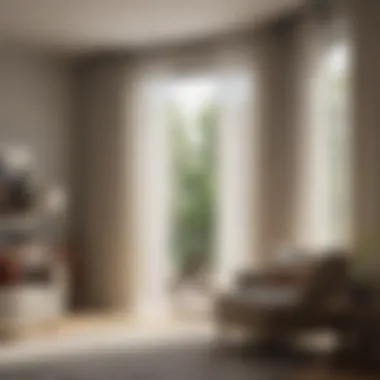
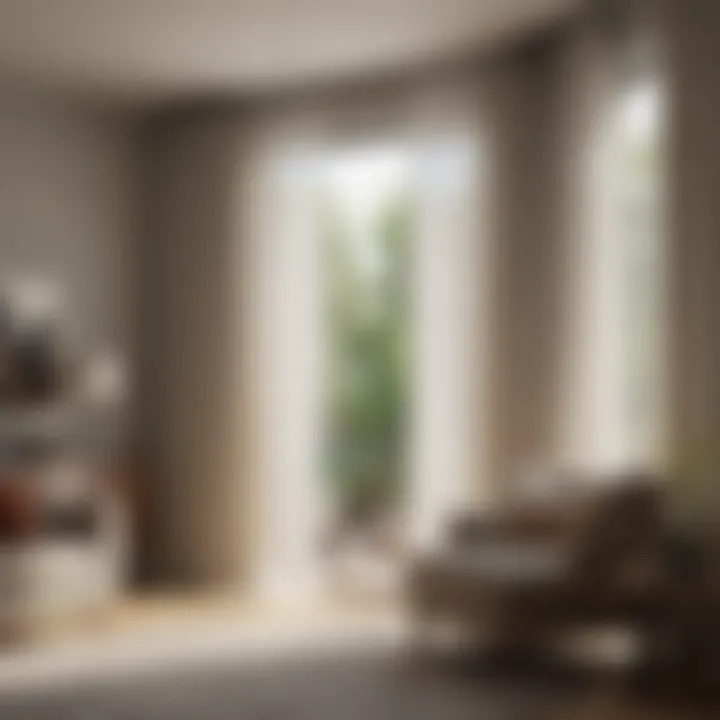
Intro
Window coverings are essential elements that enhance both the aesthetic and functional aspects of any living space. While often overlooked, the choice of window treatments can significantly impact natural light, privacy, and the overall ambiance of a room. This article will explore a broad spectrum of innovative ideas for home window coverings, suitable for various preferences and interiors. By examining diverse materials, designs, and current trends, homeowners and industry experts will gain insight into how these elements can transform their spaces, marrying beauty with practicality.
Design Inspiration
Trending Styles and Themes
The landscape of window coverings has evolved dramatically in recent years. Homeowners are increasingly interested in unique designs that reflect personal style. Some popular themes currently include minimalism, where simplicity reigns and practical materials shine. Another approach is organic design, utilizing natural fibers and earthy textures.
Among the prominent styles are sheer shades, which offer a soft diffusion of light, and plantation shutters, which bring a touch of sophistication. Roller blinds are also gaining traction due to their versatility and modern aesthetic. Each of these styles can be adapted to fit different decor themes, from contemporary to farmhouse.
Color Palettes and Combinations
Colors play a crucial role in defining the mood of a room. When choosing window coverings, it's essential to consider color palettes that complement the existing decor. Neutral tones like beige, gray, or white remain popular because they create a calm atmosphere. However, homeowners are also embracing bold colors that serve as statement pieces. Rich blues or deep greens can introduce drama, especially when paired with lighter shades or contrasting patterns.
Unconventional combinations can also be quite effective. For instance, mixing warm wooden tones with cooler fabric shades can add depth and warmth to a space.
"Innovative window coverings not only provide privacy but are also an opportunity for self-expression through design and color."
By understanding how different colors interact, one can truly personalize a living space.
Practical Applications
Material Choices
The selection of materials for window coverings is as diverse as the styles available. Fabrics range from light and airy sheer linen to heavy blackout materials. Each type serves distinct purposes:
- Natural Fabrics: Such as cotton and linen, allow light while providing some privacy.
- Synthetic Fabrics: Often more durable and easier to clean.
- Wood: Adds warmth and can be used in shutters or blinds.
- Metal and Composite: Perfect for modern spaces, offering a sleek and industrial feel.
Understanding the function of each material helps in making informed decisions that balance aesthetics and utility.
Smart Window Coverings
Technology has found its way into home decor. Smart window coverings can be controlled via smartphones or voice-activated devices, offering a blend of convenience and energy efficiency. Products like Lutron Serena and IKEA FYRTUR provide options for those wishing to incorporate smart technology.
By integrating smart window treatments, homeowners can enhance their living spaces while saving on energy costs. The ability to automate light levels and maintain privacy effortlessly is a significant advantage.
Ending
In summary, innovative window covering ideas extend beyond mere function. They allow for personal expression, enhance living spaces, and contribute to energy efficiency. By exploring the variety of styles, materials, and technologies available, homeowners can transform their environments in both meaningful and significant ways.
Intro to Window Coverings
Window coverings play a critical role in both the functionality and aesthetic of a home. From controlling light to enhancing privacy, these elements contribute significantly to the overall ambiance and comfort of various living spaces. The choice of window treatments can either complement a room's design or stand as a testament to personal style. Moreover, the right coverings can help optimize energy efficiency in the home. Understanding the many facets of window coverings is essential for any homeowner or designer aiming to create a harmonious space.
Purpose and Benefits
The primary purpose of window coverings is to manage natural light entering a room. This can lead to improved comfort levels by reducing glare and heat from sunlight. Additionally, they help maintain privacy, safeguarding against unwanted views from outside. Energy efficiency is another considerable benefit: proper window treatments can contribute to regulating indoor temperatures, lowering energy bills, and enhancing the home’s environmental credentials.
Furthermore, window coverings can be a crucial element of interior design. They can add dimension, color, and texture, helping to create a unified look while reflecting the owner’s personality. In short, the selection of window covering will have impacts that extend beyond mere functionality.
Factors Influencing Choice
Several factors play a role in selecting appropriate window coverings.
- Room Functionality: The purpose of the room heavily influences choice. A bedroom ideally benefits from blackout curtains for better sleep quality, while a living room can utilize lighter fabrics for a casual ambiance.
- Aesthetic Cohesion: Consider how chosen coverings will harmonize or contrast with existing decor. Cohesion can express sophistication or creativity in design.
- Maintenance Requirements: The fabric and material dictate the cleaning and care needed. For instance, natural fabrics may require more frequent maintenance than synthetic options.
- Budget Constraints: Window coverings come in a wide range of prices. It’s essential to assess budget limitations against desired features and quality.
- Energy Considerations: Opting for energy-efficient materials can greatly reduce home heating and cooling needs.
Choosing the right window covering is more than a mere aesthetic decision. It involves careful consideration of factors that blend style with function and sustainability.
By thoughtfully assessing these elements, individuals can select window treatments that elevate their environments and meet their practical requirements.
Types of Window Coverings
Window coverings are essential elements of home decor. They play significant roles beyond aesthetics. They regulate light, add privacy, and contribute to the energy efficiency of a space. Choosing the right type involves understanding various options, benefits, and the specific needs of each room. This section will explore several popular types of window coverings, including blinds, shades, curtains, drapery, and window films.
Blinds
Blinds are versatile and practical. They can control light and maintain privacy effectively. They come in multiple styles and materials, making them a popular choice for various environments. Their adjustable slats allow for flexibility in light control.
Vertical Blinds
Vertical blinds are known for their functionality in large windows and sliding doors. Their vertical orientation makes them easy to operate. They also give a modern feel to a room. The ability to tilt the slats provides excellent control over natural light and visibility. However, they can collect dust easily, needing regular maintenance.
Horizontal Blinds
Horizontal blinds are commonly used in homes. They provide a classic look that works well in traditional and contemporary settings. They are usually made of wood, faux wood, or aluminum. A key characteristic is their durability. However, they can block a large amount of light when fully closed, which may not be ideal for every room.
Cellular Blinds
Cellular blinds offer more than visual appeal. Their unique design creates air pockets that enhance insulation. This can lead to energy savings in both summer and winter. Their ability to be customized in color and pattern makes them highly adaptable to any decor. But, cleaning can be more complicated due to their intricate structure.
Shades
Shades provide a wide range of options for light filtering and design. They enhance privacy while adding color and texture to a space. The choice of shade can significantly impact a room's overall ambiance.
Roller Shades
Roller shades are simple and practical. They can be easily rolled up or down, providing a neat solution for light control. They come in various fabrics, from sheer to blackout. Their minimalistic design allows them to fit seamlessly into any decor. However, their fabric may fade over time when exposed to direct sunlight.
Roman Shades
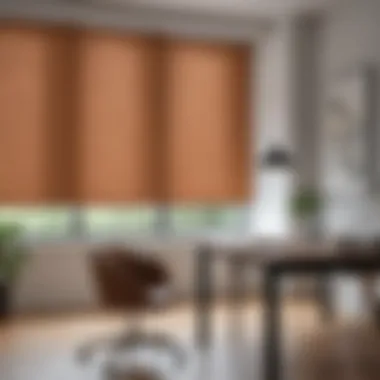
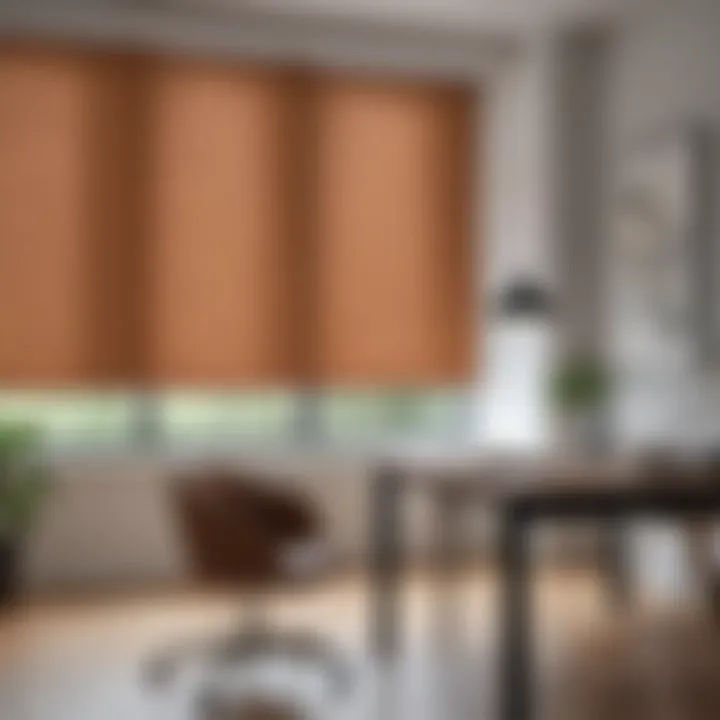
Roman shades combine elegance with functionality. When raised, they fold neatly into pleats. This provides a polished look while allowing for a customized fit. They are available in numerous materials and patterns. Nevertheless, their fabric can hold dust and require more effort to clean.
Sheer Shades
Sheer shades are designed for those who want natural light without sacrificing privacy. They consist of layers of sheer fabric that can block out or diffuse sunlight. This kind of shade adds softness to a room. However, they may not provide total darkness, which could be a limitation in certain applications.
Curtains
Curtains are traditional window treatments that remain popular. They serve decorative functions while allowing flexibility for light and privacy control. The style and length of curtains can drastically change a room's atmosphere.
Long Curtains
Long curtains add an element of sophistication. They create a sense of height in a room, making it feel more spacious. They are often made of heavier materials, which can aid in blocking light. On the downside, they require more cleaning and can pose safety concerns in homes with small children.
Short Curtains
Short curtains are practical in smaller rooms or kitchens. They provide light control while allowing visibility outside. Being easier to clean and maintain, they are ideal for everyday living spaces. However, they may not offer as much coverage as longer options, limiting their effectiveness in certain scenarios.
Blackout Curtains
Blackout curtains are essential for bedrooms or media rooms. They effectively block out sunlight, creating a dark environment. This can be beneficial for sleep quality and energy efficiency. Their main drawback is the limited options in aesthetics compared to lighter fabrics.
Drapery
Drapery represents a more luxurious window treatment. It is often heavier and lined, providing substantial light control and insulation.
Custom Drapery
Custom drapery allows for personalization. Homeowners can select fabrics, styles, and sizes that fit their decor perfectly. This can create a cohesive look in a room. However, custom options tend to be more expensive and require longer lead times for production.
Ready-Made Drapery
Ready-made drapery is often more accessible in terms of price and availability. They come in standard sizes and styles. This is a good choice for those who want a quick update without the need for customization. The major downside is limited options, which may not fit every unique window size or design preference.
Window Films
Window films are a unique choice that provides solutions without extra bulk. They can enhance privacy and add decorative elements without needing hardware.
Privacy Films
Privacy films are designed to prevent outside visibility while allowing natural light to enter. They are beneficial for bathrooms or offices. Their installation is relatively simple and can be a cost-effective solution. However, they might not work for all window types or maintain visibility over time.
Decorative Films
Decorative films add style without sacrificing function. They come in various patterns and colors, providing an artistic touch to plain glass. They can also offer some level of privacy. The challenge is selecting a design that aligns with the rest of the decor.
UV Protection Films
UV protection films are critical for preventing damage to furnishings and flooring from sunlight. These films can block harmful rays while allowing light. This helps to maintain a comfortable indoor environment. Nonetheless, they may not provide full privacy and can alter the view through the window.
Understanding the types of window coverings gives homeowners comprehensive options to select solutions that enhance their spaces effectively. Each type presents unique characteristics, advantages, and disadvantages—knowledge that is vital for informed decision-making.
Materials for Window Coverings
Understanding the materials for window coverings is crucial because they directly influence both aesthetics and functionality. The right material can enhance the beauty of a room, control light effectively, and provide essential privacy. Different materials offer varied benefits and considerations, such as durability, maintenance, and insulation. Homeowners should weigh these factors to make informed choices that align with their style preferences and practical needs.
Fabric Options
Natural Fabrics
Natural fabrics include cotton, linen, and silk. These materials often bring warmth and elegance to living spaces. A key characteristic of natural fabrics is their breathability, making them ideal for spaces that require good air circulation. They are often chosen for their environmental friendliness, appealing to those prioritizing sustainability. However, one disadvantage could be their susceptibility to fading over time when exposed to direct sunlight. This aspect requires careful placement and may necessitate seasonal changes.
Synthetic Fabrics
Synthetic fabrics, like polyester and nylon, are engineered to be durable and stain-resistant. Their key characteristic lies in their ability to withstand wear and tear better than many natural options. This makes them a popular choice for high-traffic areas or rooms with children and pets. Moreover, they are often easier to clean compared to natural materials. However, some synthetic fabrics may not offer the same aesthetic warmth as natural fabrics, which can be a consideration for homeowners focused on ambiance.
Blended Fabrics
Blended fabrics combine natural and synthetic fibers, aiming to offer the best of both worlds. This adaptability makes them a beneficial option. They often have improved durability without losing the softness of natural materials. A unique feature of blended fabrics is that they can be designed to mimic more expensive materials at a lower cost. However, in some cases, the blend can compromise the pure texture and appearance of natural fabrics.
Wood and Composite Materials
Natural Wood
Natural wood is celebrated for its timeless beauty and durability. Its ability to bring warmth and richness to any room makes it a popular choice for window coverings. One unique feature of natural wood is that it can be stained or painted, allowing for customization in various home aesthetics. A drawback to consider is that natural wood can warp or fade when exposed to moisture or sunlight for extended periods. Proper care and maintenance are essential.
Engineered Wood
Engineered wood is created by binding wood fibers with adhesives and heat to form durable sheets. Its key characteristic is very strong resistance to warping compared to natural wood. Being more cost-effective, it presents a beneficial alternative for homeowners seeking the look of wood without the high cost. However, they might lack the original texture of natural wood, which some purists prefer.
Faux Wood
Faux wood mimics the appearance of real wood but is typically made from PVC or similar materials. Its main contribution is affordability while still providing a custom look. Faux wood is resistant to moisture, making it ideal for rooms like bathrooms or kitchens that experience humidity. However, some people note that faux wood might not carry the same authentic feel as real wood, which can impact overall aesthetics in more traditional settings.
Metal and Vinyl
Aluminum Blinds
Aluminum blinds are lightweight and durable, making them a smart choice for many homes. Their key characteristic is resistance to moisture and fading. This makes them practical for rooms with high humidity, such as bathrooms. Moreover, they are available in various colors and styles, allowing homeowners to match their decor easily. One disadvantage is that aluminum blinds can be prone to dents and scratches, so care is necessary in their handling.
Vinyl Roller Shades
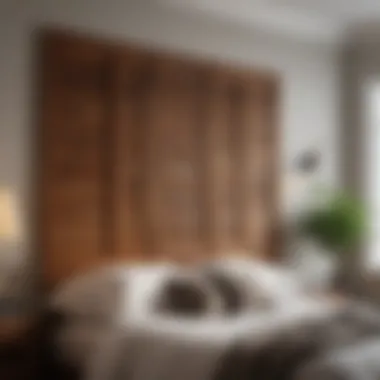
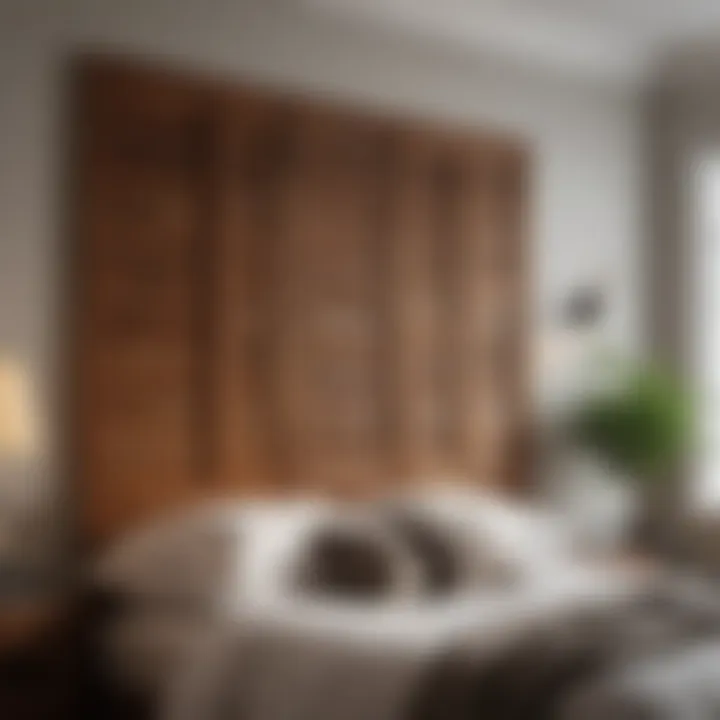
Vinyl roller shades combine functionality and style effectively. They are easy to clean, which appeals to busy homeowners. The key characteristic of vinyl roller shades is their affordability, making them accessible for various budgets. They can come in various colors and patterns, providing good versatility. However, high-quality roller shades can be substantial in weight; cheap versions may tear easily if not handled properly.
Styles and Aesthetics
Styles and aesthetics play a pivotal role in the selection of window coverings. They influence not only the overall appearance of a room but also the atmosphere it exudes. Homeowners often seek to complement their existing decor or create a distinct ambiance that reflects their personal style through their window treatments. This section delves into modern and traditional styles, examining their characteristics, benefits, and potential drawbacks.
Modern Styles
Minimalist Designs
Minimalist designs prioritize simplicity and function over ornate details. This approach focuses on clean lines, uncluttered looks, and a neutral color palette. Its contribution to innovative home window coverings is significant, as it enhances the illumination and openness of a space.
A key characteristic of minimalist designs is their versatility. They easily blend with various interior styles without overpowering other design elements. This makes them a popular choice among homeowners seeking a contemporary aesthetic. The unique feature of these designs is their ability to provide a sense of tranquility and spaciousness, making smaller rooms appear larger. However, some may find them too stark or lacking in personality.
Geometric Patterns
Geometric patterns bring a modern twist to window coverings with their bold shapes and striking designs. These patterns can invigorate a room, offering a playful yet sophisticated look. They contribute by adding visual interest without overwhelming the space.
The defining characteristic of geometric patterns is their captivating visuals. They often serve as a focal point in a room, attracting attention and sparking conversation. The unique feature of these designs is their ability to harmonize with both modern and traditional themes, providing versatility in decor. One potential downside is that busy patterns might clash with already decorative elements in a room.
Traditional Styles
Heirloom Patterns
Heirloom patterns embody a sense of history and tradition. These designs often reflect intricate motifs and come in rich colors that tell stories of craftsmanship. Their contribution to window coverings lies in their ability to instill warmth and character into a home.
The key characteristic of heirloom patterns is their complexity. Homeowners often appreciate how they can showcase family heritage or align with nostalgic values. The unique aspect is the craftsmanship that goes into them. While heirloom patterns can elevate a room's elegance, they may require more effort to style effectively, ensuring they do not overwhelm the space.
Classic Colors
Classic colors remain timeless choices for window coverings. They include shades such as deep reds, navy blues, and earthy tones. These colors contribute to a sense of stability and cohesiveness in home decor.
The key characteristic of classic colors is their enduring appeal. They harmonize well with various design elements, making them suitable for almost any room. A unique feature is their adaptability across different styles, whether modern or traditional. However, relying solely on classic colors may seem predictable to those desiring a more eclectic or vibrant palette.
"Choosing the right style not only elevates the aesthetics of your space but also aligns with your personal expression."
In summary, styles and aesthetics significantly influence how window coverings can transform a space. By understanding modern and traditional options, homeowners can make informed decisions that best suit their environments.
Functional Considerations
Understanding functional considerations is essential when selecting window coverings. This section examines various elements that influence the effectiveness of window treatments. Homeowners often seek solutions that can adjust to their needs while also enhancing the overall aesthetics of their spaces. This balance between function and form is critical in achieving a serene living environment.
Light Control
Sheer vs. Blackout
Light control is one of the foremost functional aspects to consider with window coverings. Sheer and blackout options both offer unique benefits. Sheer treatments allow diffused light to filter into a room, creating a soft ambiance. They are a popular choice in situations where maintaining brightness is key while still offering some privacy. In contrast, blackout curtains are designed to block nearly all light, making them ideal for bedrooms or media rooms.
A significant advantage of sheer fabrics lies in their ability to provide visibility without sacrificing light. However, they may not offer the complete privacy that some households require. Blackout options, on the other hand, can promote better sleep but entirely shut out natural light when drawn.
Adjustable Light Filtration
The ability to adjust light filtration is a feature that many homeowners appreciate. Adjustable light filtration mechanisms allow users to customize the amount of light entering a room. This is particularly beneficial in spaces where tasks may be impacted by direct sunlight, such as home offices or creative studios.
These treatments can range from adjustable blinds, which can be tilted to varying angles, to shades that can be drawn up or down according to preference. The adaptability makes them a favored choice. However, one must consider the complexity of operation and maintenance involved.
Energy Efficiency
Insulative Properties
Energy efficiency is increasingly becoming a priority for homeowners aiming to reduce utility costs. Insulative properties of window coverings greatly affect a home’s energy consumption. By limiting heat transfer, well-insulated covers help maintain temperature stability, reducing the strain on heating and cooling systems.
Various materials provide different levels of insulation. For example, cellular shades are particularly noted for their superior insulative effects, creating pockets of air that serve as barriers against temperature fluctuations. However, they may have higher upfront costs compared to simpler options.
Solar Heat Gain Reduction
Solar heat gain reduction is another significant consideration. Effective window coverings can reflect sunlight, thus minimizing heat build-up in living spaces. This is especially crucial in regions with high sun exposure or in homes with large windows that lead to excessive heat accumulation during summer months.
Using solar shades can be an effective way to combat this issue. They allow for reduced heat gain while still maintaining visibility outside. However, it is important to note that excessive reliance on such solutions can sometimes lead to over-illumination.
Privacy Options
Translucent Materials
Privacy is a fundamental aspect of choosing window coverings. Translucent materials strike a commendable balance by allowing light to pass while obscuring views from outside. This makes them suitable for spaces like bathrooms or living rooms facing streets where discretion is desired.
The beauty of translucent materials lies in their versatility. They can blend well with various decor styles while promoting a bright atmosphere. Nevertheless, they may not offer complete privacy during the night if lights are on inside, a point that must be considered.
Covering Strategies
Lastly, covering strategies enhance privacy by utilizing multiple layers or combining different types of treatments. For instance, combining sheer curtains with blackout shades allows homeowners to adapt to changing situations, such as daytime privacy versus nighttime light control.
Such strategies offer a level of sophistication and tailored solution, appealing to those who require flexibility. However, coordinating these approaches can complicate maintenance and aesthetics, requiring careful planning.
Selecting the Right Window Covering
This section delves into the significance of selecting the right window covering for home environments. The choice can greatly influence both the aesthetic and practical aspects of a space. Understanding your space, budget, and maintenance needs is crucial. The right selection enhances not only beauty but also functionality, such as energy efficiency and light control.
Assessing Your Space
Room Size and Layout
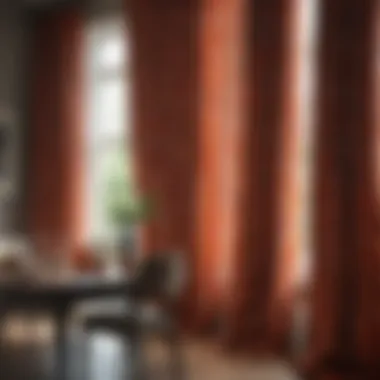
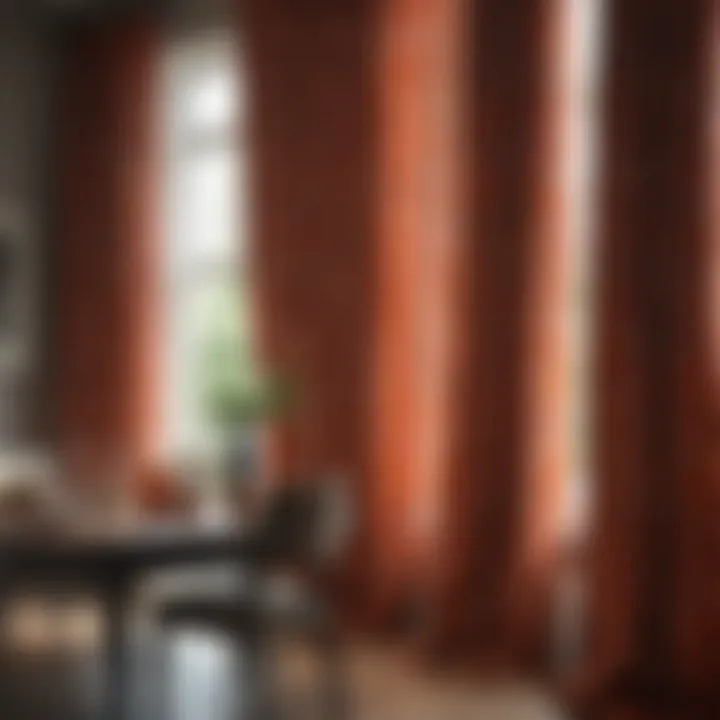
Assessing the room size and layout is key to achieving the desired effect with window coverings. A small room may feel cramped with heavy drapes, while larger spaces can handle bolder designs. The layout also impacts how much light enters the space. A well-planned choice can create a sense of balance and harmony, enhancing overall aesthetics. For example, using lighter shades in a small room can help it appear larger. Therefore, understanding your space enables you to select coverings that complement its dynamics.
Light Orientation
Light orientation refers to the direction windows face and the amount of natural light they receive throughout the day. This factor greatly influences your window treatment choice. For instance, south-facing rooms can get intense afternoon sun, making sheer shades a practical option for diffusing light. Alternatively, west-facing rooms may benefit from blackout options to block evening sun. Understanding light orientation can guide homeowners in selecting window coverings that enhance comfort while serving functional purposes.
Budget Considerations
Price Range of Various Options
Budget is a fundamental aspect when choosing window coverings. Options range widely in price, from inexpensive vinyl shades to luxurious custom drapery. Knowing the price ranges helps homeowners make informed decisions. Basic options may suffice for temporary needs, while investing in higher-quality materials can lead to greater longevity and aesthetic appeal. Thus, evaluating your financial constraints allows for a more strategic selection process.
Long-Term Value Assessment
Long-term value assessment involves considering the durability and performance of window coverings over time. Higher quality materials may have a steeper initial cost but can offer better thermal insulation and light control. Assessments should include the potential energy savings and how well the coverings endure wear. Understanding these aspects ensures homeowners choose wisely, maximizing functionality and minimizing replacement costs.
Maintenance and Care
Cleaning Tips for Different Materials
Each material requires different cleaning techniques to maintain its appearance. For instance, faux wood blinds can generally be wiped clean with a damp cloth, while certain fabric shades may need vacuuming or spot cleaning. Awareness of cleaning methods for chosen materials can influence what coverings to invest in, ensuring they remain in good condition and extend their lifespan.
Longevity Expectations
Longevity expectations refer to how long various window coverings are designed to last under typical conditions. With proper maintenance, some materials, like hardwood or metal, generally last longer, while others, such as certain fabrics, may wear out faster in high-sun areas. Being mindful of expected longevity helps homeowners understand which options offer the best return on investment and align with their lifestyle efficiency.
Effective window coverings should not only meet aesthetic needs but also work harmoniously with practical considerations.
Integration with Interior Design
Integration with interior design is crucial for achieving a cohesive and inviting home environment. The choice of window coverings directly influences how spaces are perceived and function. They play a significant role in linking different elements of decor while fulfilling practical needs.
Complementing Room Decor
Color Coordination
Color coordination involves matching window coverings with existing colors in a room. This connection amplifies visual appeal and creates a unified atmosphere. A well-chosen color palette enhances the overall aesthetic while supporting mood and ambiance.
One key characteristic of color coordination is its ability to create harmony. A beneficial aspect of carefully selected shades is their capacity to tie together various elements, such as furniture, artwork, and flooring. Neutral tones, for example, can provide a subtle backdrop, allowing bolder hues to shine. Each has advantages and disadvantages. While neutral shades offer versatility, they may lack excitement. Conversely, strong colors can energize a space but may clash with other design components if not chosen thoughtfully.
Textural Harmony
Textural harmony focuses on the interplay of materials and finishes. It creates a tactile experience, enriching the visual landscape of a room. Textural diversity can enhance depth and interest in any setting.
A vital characteristic of textural harmony is its ability to evoke feelings. It is advantageous to consider different textures—like smooth, rough, soft, or rigid—to create balance. A unique feature of textural harmony is its capacity to draw attention to particular areas of a room. However, too much variation may lead to a disjointed look, which is counterproductive.
Creating Focal Points
Using Patterns
Using patterns in window coverings can create compelling focal points within a room. Geometric shapes or floral designs can anchor a space, drawing the eye toward particular areas. Patterns reflect individual style and can transform the overall feel of a room.
A key characteristic of patterns is their ability to introduce visual dynamism. Popular among designers, incorporating well-chosen patterns can elevate the aesthetic value. One unique advantage is that patterns can cleverly disguise wear or stains, enhancing the longevity of window coverings. However, they can be overwhelming if overused, thus balance is necessary.
Highlighting Window Features
Highlighting window features enhances the architectural beauty of a home. This may involve accentuating the shape or design of windows themselves, making them a central point of interest in the room.
One defining characteristic of highlighting window features is that it draws attention to design aspects that might otherwise be overlooked. This creates an opportunity for creativity, allowing homeowners to express personal style. However, focusing too much on window features can distract from other essential design elements, leading to an unbalanced aesthetic.
Choosing the right window covering is not merely about functionality; it is about enhancing the entire living experience.
Integrating these principles into your choices of window coverings can greatly impact the design and usability of any space.
The Impact of Technology
Technology in home window coverings has shifted the way we view and utilize our living spaces. Beyond aesthetics, this integration offers practical advantages that enhance the functionality of window treatments. Smart window coverings represent a significant development, combining innovative features with convenience. They reflect modern priorities of comfort and efficiency in home management.
Smart Window Coverings
Smart window coverings incorporate technology that allows for programming and control via smartphones or other devices. This feature represents a pivotal change in how window treatments can operate seamlessly within a smart home environment. Homeowners are drawn to the potential for greater control over light and privacy while benefiting from energy-saving opportunities. Digital manipulation of window coverings makes it easier to align with everyday routines and preferences, marking a clear advantage over traditional options.
Automated Systems
Automated systems in window coverings facilitate the effortless opening and closing of blinds and shades. Their main characteristic is the integration of motors that can be set on timers or activated by remote commands. This feature is not only user-friendly but also adds to energy efficiency by allowing homeowners to optimize natural light. A standout attribute of automated systems is their ability to connect with home automation technologies. For example, integration with home security systems provides added security when the home is unoccupied.
However, potential downsides include initial costs and maintenance considerations. While installation can be more expensive than standard coverings, the long-term benefits often outweigh the upfront investment.
Remote Control Functionality
Remote control functionality offers a level of convenience that many find appealing. With this system, users can adjust their coverings from virtually anywhere in the home. A key characteristic is the ability to customize settings according to personal preferences or specific times of day. This means that shades can be lowered for privacy at night, or adjusted during the day to control heat and glare.
One unique feature is the compatibility with voice-activated assistants like Alexa or Google Assistant, enabling hands-free control. This functionality is especially beneficial for those with mobility challenges.
On the downside, reliance on technology may present a learning curve for some users. Also, if there are power outages, manual adjustments become necessary until systems are restored.
"The incorporation of smart technology in window treatments demonstrates the evolving nature of home management, reflecting broader trends in convenience and energy efficiency."
Finale
In the realm of home design, the choice of window coverings carries notable significance. This conclusion encapsulates the main aspects discussed throughout the article, emphasizing not just aesthetics but also functional benefits that innovative window covering ideas can provide. The interplay between style, practicality, and technological advancements in window coverings can significantly elevate living spaces. Understanding these elements helps homeowners make informed choices that reflect their unique preferences and enhance their home's character.
Recap of Key Takeaways
- Diverse Types: There are numerous styles of window coverings, including blinds, shades, and curtains, each offering unique advantages. This variety enables customization based on personal taste and functional needs.
- Materials Matter: Choosing the right materials is vital. Options like natural fabrics provide warmth, while synthetic materials may offer enhanced durability.
- Style & Aesthetics: Different styles cater to modern or traditional tastes, allowing homeowners to create cohesive looks that suit their overall design goals.
- Functional Considerations: Factors such as light control, energy efficiency, and privacy options are critical in making the right decision. Innovative solutions can optimize comfort and utility.
- Integration of Technology: Smart window coverings have revolutionized functionality with remote access and automated systems.
Encouragement for Exploration
The journey of exploring innovative window covering ideas should be viewed as an opportunity for creativity and customization. Homeowners are encouraged to experiment with different styles and materials that complement their interiors. Researching the latest trends can provide inspiration, leading to tailored solutions that reflect personal style while addressing practical needs. Finding the right balance between aesthetics and functionality can transform a living space into a haven of comfort and elegance. Taking the time to explore these options will undoubtedly yield rewarding results.



